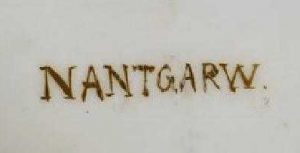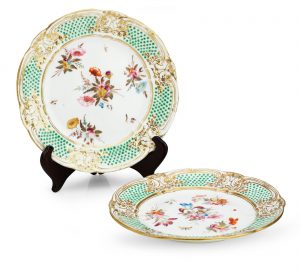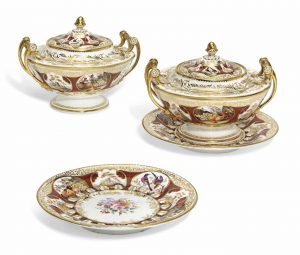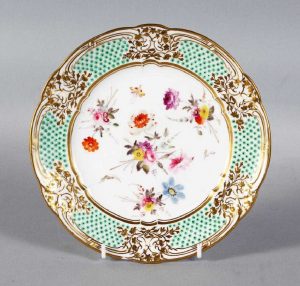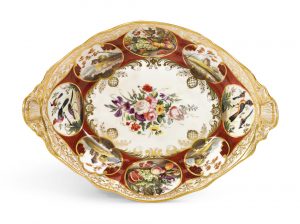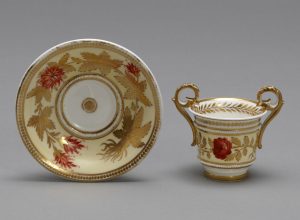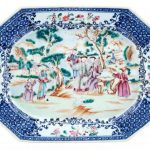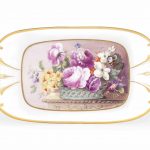Nantgarw China Works. The Nantgarw China Works was a porcelain factory, later making other types of pottery, located in Nantgarw on the eastern bank of the Glamorganshire Canal, 8 miles (13 km) north of Cardiff in the River Taff valley, Glamorganshire, Wales. The factory made porcelain of very high quality, especially in the years from 1813-1814 and 1817-1820. The body was extremely white and translucent, and was given overglaze decoration of high quality, mostly in London or elsewhere rather than at the factory. The wares were expensive, and mostly distributed through the London dealers. Plates were much the most common shapes made, and the decoration was typically of garlands of flowers in a profusion of colours, the speciality of the founder, William Billingsley. With Swansea porcelain, Nantgarw was one of the last factories to make soft-paste porcelain, when English factories had switched to bone china, and continental and Asian ones continued to make hard-paste porcelain.
The history of the ownership and management of the factory is complicated. The first formula, used in 1813-14, gave excellent results, but had an unacceptably high wastage rate, being very prone to deform (“slump”) during firing. This formula was also being used at Swansea, and pieces can be impossible to allocate between the two with confidence. After a period of experimentation, in 1817-1820 the original paste formula was used again.
After ceasing to make or decorate porcelain in the 1820s, and a period of closure, the pottery reopened in 1833, making earthenware and stoneware, as well as clay pipes, before finally closing in 1920, when cigarettes had replaced pipes. The site is now a museum, and also a working pottery. In 2017 a limited quantity of porcelain was made there, using the original formula, as reconstructed. Reference: Wikipedia
Nantgarw makers mark
A pair of London-decorated Nantgarw plates Circa 1818-20 The C-scroll borders picked out in gold and painted with tightly packed green dots, the centres with scattered flower sprays and insects, 22cm diam, impressed NANT-GARW CW
Sold for £ 600 inc. premium at Bonhams in 2019
A PAIR OF NANTGARW DESSERT-TUREENS, COVERS AND STANDS FROM THE DUKE OF CAMBRIDGE SERVICE CIRCA 1818, IMPRESSED UPPERCASE NANTGARW/C.W. MARKS TO TUREENS AND STANDS Of compressed urn-shaped form with bracket handles and artichoke finials, painted with studies of birds, fruit and buildings in landscapes within gilt oval panels on a ground of red drapery, the stands with bouquets of flowers (minor chipping to footrim of stands, minor wear to gilding) The stands 7 3/8 in. (18.7 cm.) diam.
Sold for GBP 25,000 at Christies in 2015
A NANTGARW PORCELAIN PLATE 8.25ins diameter, with gilt border, the centre painted with flowers. Impressed NANTGARW CW.
Sold for £750 at John Nicholson Auctioneers in 2018
A Nantgarw porcelain oval footed centre-dish, circa 1818-20 of Duke of Cambridge service type, London decorated with a central flower spray within a border of medallions of exotic birds, buildings in landscapes and still-lifes of fruit, reserved within rich-red drapery, the exterior with the same border, impressed NANT-GARW/ CW mark,
The present centrepiece is probably from the service gifted by the Prince Regent to his brother Prince Adolphus, Duke of Cambridge (1774–1850) on the occasion of his wedding to his second cousin Princess Augusta of Hesse-Kassel (1797–1889) in 1818. The couple were first married at Kassel on 7th May of that year then again at Buckingham Palace on 1st June. The Duke and his new wife lived mostly in Hanover where he served as Viceroy of the Kingdom of Hanover from 1816 until the accession of Queen Victoria. The decoration of the service is attributed to the Islington based workshop of Thomas Randall. For a plate from the service see W. D. John, and G. J. Coombes, Nantgarw Porcelain Album, Glamorgan, 1975, pl. 58. An example of the form from the Marquis of Exeter service was in the Sir Leslie Joseph collection of Welsh porcelain, sold Sotheby’s, 14th-16th May 1992, lot 318; see also lot 479, for a further Duke of Cambridge plate.
Sold for 4,750 GBP at Sothebys in 2018
Two-handled cup and saucer of porcelain painted in colours and gilded. Decorated with red flowers and gilt stems and vine leaves on a pale yellow ground forming a band between gilt fillets.
ca. 1817-1820 (made)
Reference: © Victoria and Albert Museum
